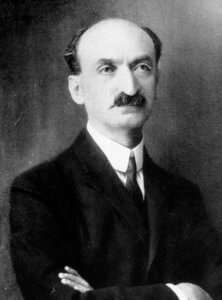Prof.Dr.Karl Holubar FRCP
Institut für Geschichte der Medizin
Währinger Strasse 25
A-1090 Vienna, Austria
KH.histmed@univie.ac.at
« Ad nos vix tenuis famae perlabitur aura »
(Virgil Aeneid, vii:646)
[« There scarcely wafts to us a thin breath of their fame »]
Reprinted with permission from Wiener klinische Wochenschrift 2003 ; 115:71-72

This year (2002) is a Kaposi Centennial Year (1,2). It should be the proper point of time also to remind of the not so big « shots » – lest they be forgotten. Especially, if they originate from the same region of Southwestern Hungary, and share some other characteristics with the grandmaster.
Once upon a time, Jadassohn´s encyclopaedic and monumental handbook (Handbuch der Haut- und Geschlechtskrankheiten, Springer, Berlin 1927 and after), comprising of more than 40 volumes, was the Bible of the discipline (edited by Joseph Jadassohn, Breslau (Wrocław), 1863-1936)(3). One might compare it to « Der Grosse Pauly », handbook for everything relating to classical antiquity, which comprises of even more than 70 volumes, or the Enciclopedia Italiana Treccani, again having more than 40 oversized volumes. Post-World War II German dermatology, under the leadership of Alfred Marchionini (1899-1965) in Munich, attempted to follow up this handbook by a supplementary edition(4). Quite an endeavour! Still some 20-odd volumes, but, alas, times had changed, English had become the language of dermatology, German was discredited beyond measure. One of the bitter ironies of history, – Jadassohn´s incomparable series is forgotten by today, both the original and the supplementary edition. A triumph of the evil of holocaust and anti-Semitism over the vision and work launched by a Jewish dermatologist. The author of these lines devoted ten years of his early time in the field, to compile four chapters for the supplementary edition. Two of these chapters were the first comprehensive monographs ever on the respective topics – they are never quoted anywhere. If it is not in English, it is overlooked. Admittedly though, the price of the volumes of the supplementary edition was so inexorably high, forbidding in fact, that it increased the paucity of issues available to students and doctors alike. Soma Cornelius [Samuel] Beck (Fig.1), to whose memory this article is devoted, was head of dermatology at the University of Pécs (Fünfkirchen, Quinqueecclesie), one of the oldest universities in Central Europe, founded in 1367 (after Prague 1348, Krakau 1364, Vienna 1365). He wrote about the « Epitheliome, » as was the customary term at the time, in the original edition of the « Handbuch ». And I was to write on these topics forty years later. I never consulted an article more often than I looked into Beck´s during all these years. In 2003 it will be 70 years that the volume with Beck´s article appeared in print (5), and on 26 April 2003 it will be 73 years that he died. Consequently, he did not see in print what he elaborated. Anyway, it is my obligation and my desire to conjure up the memory of a scholar who devoted so many years to a subject, dear especially to Hungarian dermatology, to the discipline in general, and to myself (on account of the gallons of sweat that went into it). In elaborating some details here, I rely on information kindly provided by esteemed colleagues, namely, one of his successors in the chair in Pécs, Professor Imre Schneider(6), by Professor (Mme.) Sarolta Kárpáti, Budapest and by previous articles, especially by the late Professor Lajos Szodoray, Debrecen(7), whom I had the honor to know personally.
Soma Cornelius Samuel Beck was born into a Jewish family in Készthely, Komitat Zala, on the shores of Lake Balaton, on 3 August 1872, circumcised 10 August, son of Wilhelm and Adelina Beck, née Bruck . Elementary school he attended in his native place, then turned to the Catholic gymnasium in Szombathely (Steinamanger), later to the Protestant gymnasium in Budapest. There he entered medical school and eventually graduated MD, in 1895. He worked in anatomy and physiology, later obtained a scholarship for travelling abroad in the years 1896/97, devoting himself to histopathology and bacteriology of skin diseases. He stayed at Isidor Neumann´s (1832-1906) department in Vienna, with Louis Ranvier (1835-1922) and at the Hôpital Saint-Louis in Paris, and with Paul Gerson Unna (1850-1929) in Hamburg before he returned to Budapest. He soon started to collaborate with Edmund (Ödön) Krompecher (« Mr. Basalioma ») on topics of histopathology and, with a common publication, won a prize in a concours initiated by Unna. In 1905 he became « dozent » for skin and venereal diseases and for pharmacology at Budapest University. During World War I he served in a military hospital. Thereafter, on 4 January 1922, he became chairman of a dermatology department, a unit which was displaced from Pozsony/Pressburg, i.e. Bratislava of today, to Budapest, because of the Treaty of Trianon. In 1924 he moved to Pécs University with this department which he headed till he died on 26 April 1930. His main area of work was histopathology of cutaneous epidermal neoplasms: with Krompecher, he wrote about « Die feinere Architektur der Hautkarzinome », and other papers on elastic fibres and lymph vessel architecture in skin. Eventually, he covered the chapter « Epitheliome » in J. Jadassohn´s Handbuch, as alluded to above (vol XII part 3/II)(5). Due to his untimely demise the latter chapter was finished by his pupil Mihály Lang.
Beck and his wife were socially active persons who cared very much about students and their lives and problems, they held afternoon teas and engaged in other fund raising activities to support students.
I have no information of any progeny of his.
It may sound odd but due to the same area of work and the many years spent working on these topics, by him as well as by myself(8), by my frequent « visits » to his text, – he became dear to me long before I ever went to Pécs, to visit Professor Schneider, emeritus by today, who graces me with his benevolence and collegiality. Pécs, incidentally, is the birthplace of one of the great ophthalmologists of the IInd Vienna School, Anton von Rosas, to whom I have paid attention in an earlier paper (9), which was dedicated to « my own » gymnasium, BRG XII « Rosas-Gasse », in Vienna. Anyway, Soma Beck´s picture adorns my windowsill in the venerable Domus Jospehina (today the Institute for the History of Medicine) and I have his face literally before me every day. As we learned above, he attended Catholic and Protestant schools. At some time of his life he must have changed his denomination, because he is buried in a Christian cemetery in Pécs (Fig.2). Thereby, he parallels his famous countryman, also born in Southern Hungary, namely in neighbouring Kaposvár, Moriz Kaposi (1837-1902). It is incredible, how much has been gossiped, speculated and theorized about such changes in denomination. Unreasonable as it were at any time. Does it really matter if somebody prays « ha-Shem eloheinu ha-Shem echad« , « Allahu ahad Allah-ssamad« , or « Credo in unum Deum« . Is it not faith that counts, it is love delivered, « a human being » addressed and turned to, in happiness and in misery, – forgiving when needed,- instead of bigotry and ritus?
Soma Beck, is one of my secret personal heroes, close to my heart at all times, because of his work, because of his spiritual liberty, because of his being a dermatopathologist. These lines may serve to remind a dermatological (and perhaps a bit, even a general medical) readership, that he was around, and lived, and worked, and died – and IS NOT ENTIRELY FORGOTTEN.
References
-
(1) Holubar K Fatović(2) -Ferenč(3) ić(4) S: 1902-2002: A hundred years later. Moriz Kaposi 1837-1902: a historical reappraisal. Wien klin Wschr113/22 (2001) 885-891
-
(5) Schneider I: To the Hundredth Anniversary of the Death of Moriz Kaposi (1837-1902). Acta Microbiol Immunol Hung 2002; 49:501-506
-
(6) Jadassohn´s Handbuch der Haut- und Geschlechtskrankheiten, Jadassohn J ed., Springer, Berlin, 1927 ff.
-
(7) Jadassohn´s Handbuch der Haut- und Geschlechtskrankheiten Ergänzungswerk, ed. by Marchionini A, Springer, Heidelberg 1964 ff
-
(8) Beck SC: Epitheliome, in, Jadassohn´s handbook, see ref. #2, vol XII/3, part II, pp 208-550 and 1136-1137
-
(9) Schneider I: Curriculum vitae, personal communication 2002
-
(10) Szodoray L:Orvostöréneti közlemények: Beck Soma Professzor emlékezete. Communicationes de historia artis medicinae 1974; 73-74:215-219
-
(11) Holubar K: Basaliom; Basalzellnaevus-Syndrom, Intraepidermales Epitheliom, Epithelioma calcificans Malherbe, in, Jadassohn´s handbook, (Ergänzungswerk /supplementary post World War II edition), see ref. # 3, vol III/3, part A, pp 235-464
-
(12) Holubar K: Anton (von) Rosas (1791-1855): On the occasion of the bicentennial of his birth. Wien.klin.Wschr. 1991; 103:470-472
Acknowledgments
-
Prof. Dr. Imre Schneider, Pécs, Hungary
-
Prof. Dr. Sarolta Kárpáti, Budapest, Hungary
-
The Jewish Community Kiszthély, Hungary (via Zala Megyei Levéltar)
